The Luxembourg gardens palace is located in the 6th arrondissement of Paris… its creation was conceptualised by Marie de Medici (King Henry IV’s widow) in 1612. The French senate sits in the palace that adorns the garden; the entire property spans almost 60 acres and has an English garden, French garden apart from fountains, ponds and a nice collection of statues. The Luxembourg gardens are said to be the largest public park of Paris; this is where the Parisians come to relax, exercise and bring picnic hampers.
History
The conceptualisation of the gardens began when Marie de Medici commissioned the building of a palace and a garden that would be similar to Pitti palace property in Florence. Hotel du Luxembourg was purchased (this is the Petit Luxembourg palace) and vigorous preparations for the gardens commenced. 2000 elm trees were planted and a fountain, grotto and nympheneum were constructed…the original size of the garden was just 8 hectares.
The Luxembourg gardens were not favoured by later members of the French royalty and a part of it was also realloted for the development of real estate. Post the French revolution the French directory leaders confiscated some of the land of the Carthusian monks and then the Arc de Triomphe architect Jean Chalgrin took on the task of reassembling the garden.
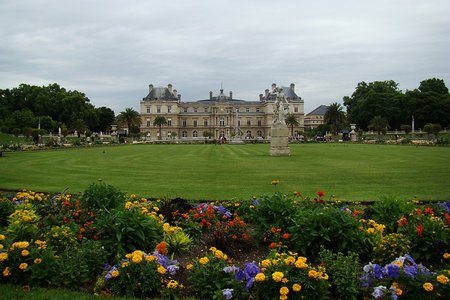
Right now about 106 statues are spread throughout the garden and most of these were acquired during and post the 1848 new monarchy…a large collection of kings, queens, writer and artist monuments along with some philosophical sculptures. Try spotting the statues of some well known icons like Beethoven and Chopin and admire the small scale version of the statue of Liberty!! The beautiful ornamental fences and gates around the park were built by Gabriel Davioud and the Chartreux nursery garden was transformed into what is now known as “English Garden”
Features
A lush green parterre of lawn and gravel decorated with statues and big water basin with a fountain dominates the remarkably serene Luxembourg gardens. There are elevated balustrade terraces flanking the basin and there are statues of queens, saints and kings. The palace (now the senate residence) and museum, orchard, hot house and lots of statues dwell in the lovely garden.
The gazebo near the pond of Luxembourg garden hosts musicals and dancing shows (costumed ones!!). The centre of the park right in front of the palace is the French style garden with clear geometric lines and flower beds and ponds. The rest of the garden is English style with trailing paths, random shrubbery and a lovely carefree beauty.
Lots of benches punctuate the garden and there are perfect places for reading a book or playing a game of chess. On a random day you can see lots of people exercising, doing yoga or tai chi and kids taking pony rides. Fantastic views are available from the garden and from the western end of the property you will be able to spot the Eiffel Tower.
Fountains
Medici fountain: At the very centre of Luxembourg gardens there is a monument which was said to be one of the most romantic fountains of the world.
There is a centre figure set symbolising Galatea and Acis lying side by side under a rock and Polyphemus aiming a rock at the couple. The side niches have statues of fauna and huntress. The back front of the fountain has a bas relief that shows Jupiter and Leda morphing into a swan. A romantic symbol of the original Italian character of the garden and property the Medici fountain is now ignored and rather forlorn. Incidentally this is a grotto fountain built to look like an artificial cave… complete with an aqueduct that was a fine example of Italian engineering. A big rectangular basin with 2 identical rows of plane trees flank the grotto and make the place look serene and romantic.
Apart from the famous Medici fountain there are others like Fontaine de Leda (right at the back of Fontaine Medicis), Fontaine Delacroix (built to honour French painter Eugene Delacroix. The Fontaine de l’Observatoire is another important monument dating back to 1873….it shows a globe carried by 4 ladies, each of whom represents a continent.
Orangery and Hothouse
If you take the left path while facing the palace you will reach the Orangerie. The orangery was built in 1830 and it contains more than 200 plant tubs that contain pomegranate, palm trees, oranges, rose bays and oleanders. There is also a greenhouse inside the orangery. Sometimes free art exhibitions are hosted here. The best day to visit the Orangerie and greenhouse is the Journée du Patrimoine’ (heritage day) that happens in September.
The hothouse is only accessible to the public on European heritage days and it contains a fantastic orchid collection that’s a property of the Senate.
Fruit Gardens
The Carthusian monks of Paris first established the fruit garden in medieval times and right now 210 types of pears and 320 varieties of apple are housed in the fruit gardens….yes, the garden hosts more than one orchards!! A tiny orchard grows a luscious crop of pears that are consumed by senate members while the rest is given away to charity.
There are beautiful antique bee boxes near the fruit orchard and a beekeeping school (Rucher Ecole) that dates back to 1856. The honey is harvested and sold at the annual honey fete (Fete du Miel) that happens each September. The bees have moved to fashionable quarters…hives with designer copper roofs and personal fountains.
Statues
There are more than 100 statues that date back to 19th century scattered around the gardens. Some notable ones are the miniature version of statue of liberty, the fountain of Observatory is particularly remarkable as it’s entirely made of shimmering bronze and is the result of collaboration between 4 French sculptors.
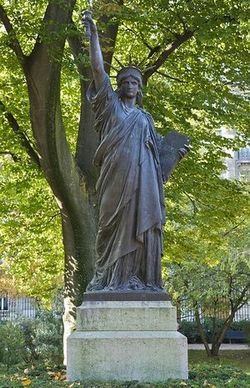
Park Activities
A complete package of educational and recreational activities are offered by the park management for kids between 1.5 to 12 years. Kids between 1.5 years to 6 years can avail the crèche services that are available from 2 pm to 6 pm from the month of May to September.
The playground has slides, swings and play zones suitable for kids between 7 to 12 years. The puppet theatre (theatre du Luxembourg) is active on Wednesday and on the weekends from 2 pm onwards and on school holidays from 4 pm onwards.
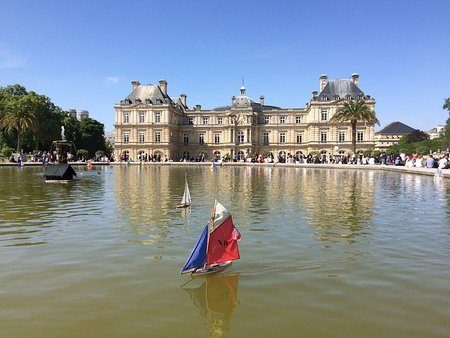
There are facilities for pony riding, tennis and swings in the park. Chess boards and bridge facilities are also present. One of the playgrounds has an old fashioned carrousel. The large park pond has a collection of remote controlled model yachts (the old fashioned wooden ones with actual sails) which can be rented and then navigated around the water body….this can be a fun activity for slightly older kids.
This is a very popular destination for picnics and you can even order picnic supplies like blankets, food and wine hampers from service providers like Paris Picnic.
Palace
The Luxembourg palace was reconstructed from the Palais Medicis in enumeration of the Palazzo Pitti of Florence. The architect Metezeau designed the palace and Marie de Medici dwelled in the right wing of the west side while a similar suite on the east side was reserved for Louis XIII. A succession of French kings and queens dwelt in the palace and each left some architectural signature.
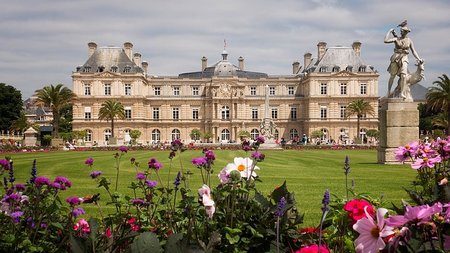
From 1750 the Palace was converted into a museum and it’s actually the predecessor of Louvre as most of its collections of paintings were moved there. Then it became a prison during the French revolution and the official residence of French directory and in 1799 the senate formally took seat in the palace. The palace that’s seen today bears a transformed look that was the brainchild of two important figures… Napoleon III who employed Chalgrin to give the palace a makeover in 1804 and King Louis Philippe who employed Alphonse to enlarge the palace structure.
The Palais du Luxembourg stands in middle of the park and is occupied by the Senate. The senate library has more than 450,000 books and is a tour worthy place. The palace building with its Rocaille features and nice collection of paintings and sculpture is worth a guided tour.
Palais du Luxembourg official tours are organised on Mondays and Fridays on the days that Senate is not in session.
The tour can be organised for 40 people at the maximum. Open for the European Heritage Days i.e. the 3rd weekend of September. There are accessible lifts and toilets on the first two floors of the Luxembourg palace.
More information can be procured by mailing [email protected]
Museum
The Luxembourg museum is a part of the Luxembourg Palace…temporary painting exhibitions are nowadays featured here. Expect showcases of the work of a particular artist or an exhibition about a historical person. In medieval times 24 Ruben paintings that glorified the Medici family and 100 paintings from the royal collection were displayed here. Right now they are housed in the Louvre and since 2010 the Public Establishment of the Réunion des Musées Nationaux and of the Grand Palais des Champs-Elysées (formally known as RMN GP) is managing the Luxembourg museum though the senate still uses the palace building. Exhibitions of living artists are held here on 3 dominant themes; art and power, gardens and palace, and European Renaissance
Museum timings 11 a.m. to 7 p.m.
Monday to Thursday and Sunday: 10.30 a.m. to 10 p.m.
19 rue de Vaugirard – 75006 Paris
Phone: 01 40 13 62 00
Open Hours, Tours & Tickets
Luxembourg Gardens is open every day but its opening hours change according to the season.
Summers: 7.30 a.m. to 9 p.m.
Winters: 8.15 a.m. to 4.30 p.m.
The park gardeners offer an informative guided tour on the first Wednesday of each month from April to October and it starts from the observatory gates from 9.30 a.m. Entry to the museum is via a paid ticket… tickets cost about 10 euros but entry to the garden areas are absolutely free!!
You can book guided tours online through this Viator site.
Location & How To Reach
The Luxembourg Gardens & Palace stretches between the Latin Quarter and St Germain des Pres neighbourhood in the 6th arrondissement of Paris….south of the river Seine. There are multiple entrances to the garden including Place Edmond Rostand, Rue de Vaugirard, Andre Honnorat, Rue Guynemer and they are also accessible by wheelchair. The Luxembourg museum lies on the north west of the park and is accessed by a separate entrance. Each entrance has a map that will help visitors navigate different sections. Some of the entrances have public toilets near them.
The garden is ideal for relaxation, picnics, photography and nature watching and once you get hungry head off to the two refreshment stalls inside that serve a wide variety of finger food. Apart from this many kiosks sell confectionery, toys and food in different sections of the garden.
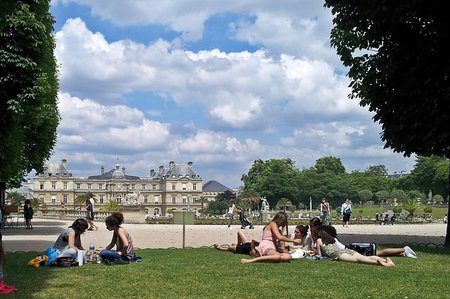
Once you visit the garden you should definitely explore the Place de la Sorbonne with its bevy of charming cafes and the antique looking Sorbonne University. Go across the street from the gardens and up a small hill to look at the Pantheon…one of the most interesting attractions of Paris. The south and west edges of the garden fall in the St Germain des pres neighbourhood and this is where the intellectual minds of Paris like Jean Paul Sartre and Simone de Beauvoir roamed around. The Musee Cluny stands in a gorgeous medieval palace. The Notre Dame cathedral is about 20 minutes away by walking.
The nearest metro station to the Luxembourg Palace are the Odeon (accessed by line 10 & 4), Saint Germain des Pres (line 4) and Mabillon (line 10), cluny La Sorbonne (Metro 10) and Saint Sulpice (metro 4)….all these stations are at a walking distance from Luxembourg.
The nearest RER station is Luxembourg and bus routes 58, 84 and 89 stop near the Palais du Luxembourg.
Address
Rue de Médicis – Rue de Vaugirard
Phone: +33 (0) 1 42 64 33 99; 33 1 42 34 20 00
 A travel addict. Still celebrating the day when he quit his high-profile corporate job to pursue his passion for travel writing.
A travel addict. Still celebrating the day when he quit his high-profile corporate job to pursue his passion for travel writing.